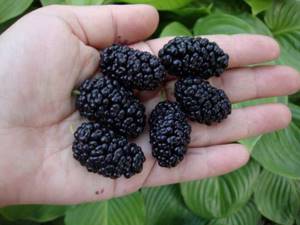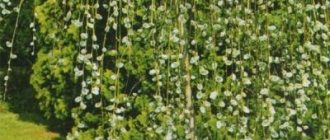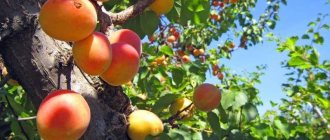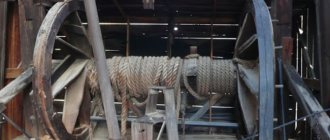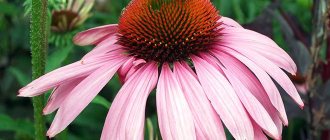Mulberry (also known as mulberry, tyutina or mulberry) is the owner of delicious fleshy berries; today it is also popular for growing as rowan, pine, pear, and cherry. Its aesthetic properties are in no way inferior to its taste, so it is also a wonderful decoration for the garden. Mulberries are also used in folk medicine, in industry, and, of course, mulberries are the main dish for the silkworm.
Types and varieties of mulberry
The species classification of mulberries is quite confusing and causes a lot of controversy among botanists. This happens due to the impressive number of hybrids, which some botanists recognize, but others absolutely do not. Various sources claim that the genus contains from 16 to 400 species. Below we present three main types.
Red mulberry (Morus rubra)
Although trees of this species are not particularly tall, they are quite spreading. It is the berries of this species that are so similar to blackberries. Red mulberry grows in many countries of temperate and subtropical zones. Its limit is the north of Belarus; at the latitude of our Northern Capital it usually freezes.
Black mulberry (Morus negro)
It is found in many countries, but the birthplace of the tree is considered to be Persia, from where the black mulberry was brought to other habitats. The species has a rather dense crown, strewn with ovate leaves with serrated edges, and the fruits are very fleshy.
Varieties of black mulberry:
- Kherson - small in stature, with good frost resistance;
- Black Baroness - has good frost resistance, early (already in June strewn with large berries);
- Plodovaya-4 is a small but very fertile tree; its berries are suitable for long-term transportation.
White mulberry (Morus alba)
A tree with a spreading spherical crown, characterized by high growth, the trunk and large branches of which are covered with grayish-brown bark. These dioecious plants bloom in April-May and bear fruit in May-June.
Varieties:
- Golden - got its name due to the color it acquires in the spring; it is a tall tree with large fruits;
- White honey is a tree with high yield and snow-white sugar fruits;
- Victoria is a small tree with huge juicy fruits.
Summary characteristics:
| properties/types | Red | Black | White |
| Frost resistance | good | ||
| tree height, m | 10—15 | 11-13 | 13-18 |
| leaf length, mm | 70-140 | 100-200 | 30-150 |
| leaf width, mm | 60-120 | 60-100 | 60-110 |
| leaf shape | asymmetrical | oblong | cylindrical |
| leaf color | bright green | ||
| type of fruit | Polydrupe | ||
| fruit color | dark purple | dark purple | white or pinkish |
| taste | sweet and sour | sweet | sickly sweet |
| fruit length, mm | 20-30 | 20-50 | 40-50 |
Winter care
Preparing the plant for winter depends on where the mulberry grows. In order for her to calmly survive the cold period in the northern regions, she must be properly prepared. Wrap the bottom of the trunk with covering material, bend the branches to the ground, cover with the same covering and secure with stones. Cover the soil at the root with dry leaves or sawdust.
In areas with “mild” winters, such care is only needed for young trees; an adult mulberry tree no longer needs careful wrapping.
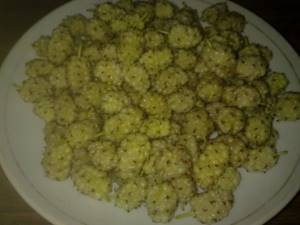
With proper care, white mulberry will delight you with a rich harvest of healthy berries, which are easy to collect - just spread any thick fabric under the tree. Ripe fruits will fall and the gardener will only have to collect them.
Planting mulberries in open ground
The first thing to do is to determine a comfortable place for the future tree. It should be light, protected from winds, the soil should have sufficient moisture, contain a moderate amount of salts and not be swampy. It is better to place the tree in the corner of the site, because The fruits on the branches of the tree do not last long, and then fall to the ground. This way the mulberry will not cause you any inconvenience. We recommend purchasing seedlings from three years old that have already produced their first fruits, because... Trees bear fruit only with female flowers, and it is impossible to determine the sex of a plant until three years old.
What time to plant
Although you can also plant in the spring, it is recommended to do this in the fall (before the rainy season begins): a tree that has survived the frost will delight you with its external beauty and fruits for a long time.
Planting mulberries in autumn
The pit should be ready 15-20 days before planting and the roots of the tree should easily fit into it. If the soil is rich in useful substances, then the hole needs to be made about 50 cubic cm, but if the soil is poor, then you should dig so that 5 kilograms of compost with one hundred grams of superphosphate fits. After application, the fertilizer must be sprinkled with soil.
Landing algorithm:
- place the roots of the seedling in the pit,
- straighten them and dig them in, shaking the trunk periodically;
- compact the disturbed soil and soak it with twenty liters of water;
- When the soil has absorbed all the water, cover the surface with mulch.
If the seedling is weak, then before planting, drive a support into the middle of the pit, and if the soil is heavy and clayey, then build a drainage layer from broken brick, pebbles or expanded clay - it will help remove moisture out and give the plants the opportunity to breathe normally.
Spring planting
The rules and algorithms for autumn and spring planting are almost the same, the only difference is that in order to plant a tree in May, a foundation pit is prepared for it in September, and compost is then poured into it. In the spring, you can safely begin to plant young plants in already fertilized soil; planting should be completed before the end of the third ten days of April.
Growing mulberries in the garden
Regular watering, removing weeds, spraying and loosening the soil around the trunk is required only when the mulberry tree is young. After the plant is 3-4 years old, you will only need to feed it and do formative pruning on time, because The tree will provide itself with moisture on its own.
Mulberry processing
The mulberry tree is not particularly susceptible to disease, but it can become infected from other trees. Insects and caterpillars will also not neglect the deliciousness in the form of tender leaves. To protect, it is necessary to periodically carry out preventive maintenance. It is necessary to spray the soil around the trunk, and not just the trunk, stems and leaves of the plant.
It is recommended to treat mulberries with a 7% urea solution in the spring and a 3% solution of Bordeaux mixture in the fall - preferably in early April. Among the folk methods, there are options using a decoction of tobacco and wormwood.
Watering mulberries
According to the advice of gardeners, it is recommended to water the tree regularly and in sufficient quantities from the beginning of April, if spring is not rainy, and mid-summer. From the beginning of the second month of summer, it is no longer possible to water the plant - this is done so that the tree prepares for frost.
Mulberry feeding
Fertilizer application is the most important part of safe and successful mulberry cultivation. From April until mid-summer, mulberries need regular fertilization. In spring, mulberries require fertilizers with a high nitrogen content, especially for young trees. This important component helps them develop and stock up on nutrients, and in the summer it is better to fertilize them with phosphorus or potassium.
The best time to start fertilizing is during the bud break phase, as this is when the plant needs it most. It is recommended to use nitrophosk, liquid solutions of manure (proportion 1:10) or bird droppings (proportion 1:15) as fertilizers. They need to be added to the soil located around the tree, which should first be loosened and then covered with a layer of compost (the so-called “mulch”).
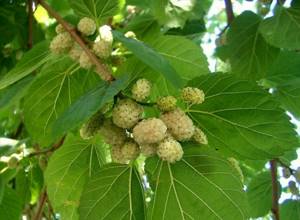
The mulberry tree easily tolerates pruning, which is recommended to be done when the plant is dormant - in early spring or late autumn.
Landing Features
Experienced gardeners recommend planting seedlings on the site that have reached the age of 3-4 years, since the mulberry tree begins to bear fruit only at the age of five.

You also need to take into account that fruiting most often requires at least two trees - a male and a female. There are also monoecious varieties that do not require planting a male tree nearby.
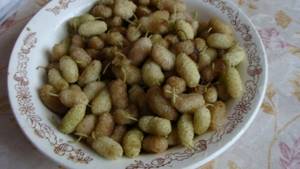
Mulberry pruning
The mulberry tree easily tolerates pruning and shearing, so each of them can form a tree to their own taste. It is recommended to prune when the plant is dormant - in early spring or late autumn. In the northern regions, it is recommended to form stlanets, not forgetting about its shelter for the winter. Sanitary pruning of mulberries should be done in early autumn (before -10C).
How to trim mulberries
Each type of tree requires an individual approach to pruning. So, the weeping mulberry needs to be thinned out and its shoots shortened, while the standard mulberry only needs to form a crown. The most difficult task is the formation of a decorative tree and the further maintenance of its given shape.
Mulberry pruning in spring
During the period of “youth”, all branches at a height of up to 150 cm are removed from the trunk so that in the future they do not hang down to the ground. From the preserved leader, you can form a low tree that will be easy to care for. This can be done as follows: cut the top at a height of 130-160 cm and form a skeleton with 8-10 branches. Next, you will need to maintain the shape, for which you need to regularly remove excess stems. Drooping branches should not be pruned; instead, simply prop them up.
Mulberry pruning in autumn
An autumn sign that it’s time to start pruning a tree is the fall of leaves. When all the leaves have fallen from the mulberry tree, it is time to prepare it for the cold, the so-called sanitary pruning - all broken, diseased and simply damaged branches should be removed.
This procedure needs to be carried out every few years.
Features of cultivation
Mulberry is considered a rather unpretentious plant, however, there are rules that must be followed when caring for it. Mulberries do not like large amounts of moisture, so watering should be limited during the rainy season. In dry weather, it will be enough to water it occasionally at the rate of 10 liters of water per bush. From mid-summer it is better to stop watering completely.
To avoid loss of moisture, the soil around the mulberry must be periodically removed from weeds, loosened and mulched with sawdust. Pruning and crown formation should be carried out before buds appear or after leaves fall.
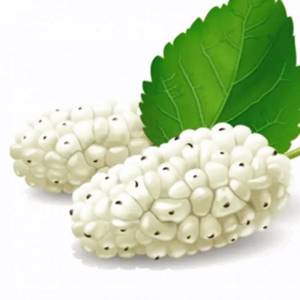
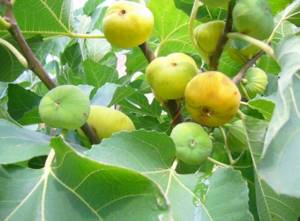
Growing figs at home - tips and instructions for care and maintenance indoors (155 photos and videos)- Norway spruce - general information, description, properties, characteristics and cultivation features. 105 photos of using spruce in landscape design

Why cherry trees dry out after flowering - searching for the reason and tips on how to save the tree and harvest (125 photos)
Do not forget about feeding the plant, especially during the fruiting period. The first time this is done is in early spring. For each m2, add a solution of nitroammophoska (50 g per 10 liters of water).
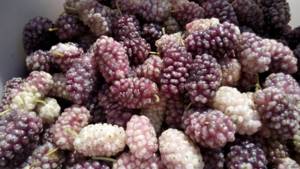
The second feeding occurs at the beginning of summer. Any ready-made mixtures for fruit and berry crops can be used. Last feeding in late autumn. For this purpose, potassium-phosphorus mixtures are used.
Mulberry propagation
There are the following methods of mulberry propagation: generative (seed) and vegetative, now we will learn more about them.
How to grow from seeds
First, you need to extract the seeds from the fruit; the berries must be from a fresh harvest. After this procedure, the seeds are left for 1-2 hours in a solution of Epin or Zircon, which stimulate growth, and sown. In the spring season, it is necessary to carry out pre-sowing preparation (before sowing, immerse the seeds in water at a low temperature for 24 hours, and then keep them for the same amount of time in water with t = 51-54 oC) or stratification (simultaneous influence of cold and humidity), it is necessary to carry out for 4-8 weeks.
For the landing site, you should choose an unshaded area. The plant needs a lot of sun. After choosing a suitable location, follow the following algorithm:
- create grooves on the surface of the soil and fill them with water and fertilizer;
- sow to a depth of 3-5 cm;
- water the furrows again and cover them with a layer of mulch to retain moisture in the soil (when sowing in the fall, add a larger layer to protect the seeds from the cold).
Caring for seedlings consists of systematically saturating them with moisture, applying fertilizers and eliminating weeds around the trunk. Closer to September, the sprouts will have grown, become stronger and will be ready for planting (the distance between plantings is 300-500 cm - depends on the variety). The first fruits will appear in 5-6 years. This is a simple and time-tested method, but it has one significant drawback - seedlings may partially inherit varietal characteristics or not inherit them at all. It depends on your luck.
Mulberry propagation by offspring
If a tree is damaged by severe frosts, it can be replaced with a developed adventitious bud, on which a crown is formed over time. Excessive young shoots should be removed, reducing them by a third, and then the shoots should be used as seedlings. The advantage of the method is that the resulting plants completely adopt the varietal properties of the mother plant.
Mulberry propagation by cuttings
For self-rooted trees, reproduction by green cuttings is also used, but this will require additional devices and devices, because in the greenhouse it is necessary to create a foggy suspension. The method is based on the formation of adventitious roots and cuttings for it are prepared in early summer.
The work algorithm is as follows:
- cut cuttings 150-200 mm long with two or three buds;
- plant at an angle of 45 degrees (if the soil is loose, then deepen it by 3 centimeters);
- cut the leaves in half and treat the lower sections with a root formation stimulator (recommended is Kornevin or heteroauxin);
- provide high humidity in the air.
The tree will be pleased with young shoots and strong roots in the fall, but it will be possible to plant it only in April.
For rooting, so-called semi-lignified cuttings are also used. The time and method of harvesting them are absolutely identical, but you will have to wait much longer for the roots to appear.
Mulberry obtained from cuttings also fully inherits varietal characteristics.
Mulberry grafting
Without exception, many grafting methods are suitable for mulberries, but the most popular is the copulation method. In conventional copulation, rootstocks and scions of the same thickness merge. Algorithm:
- make oblique cuts on the rootstock and scion between two buds, the length of four plant diameters (example: if D = 1.6 cm, then you need to perform the following action: 1.6 * 4. It turns out that the length of the cuts = 6.4 cm );
- align the sections and tie them with polyethylene or other elastic material.
When using copulation with a tongue, the cuts are made in the same way as with a simple one, but with the addition of tongue-cuts. Algorithm for such copulation:
- Having prepared the sections, you need to make a cut to the center at a distance of 1/3 from their end. Down - on the rootstock and up - on the scion;
- press them closely together and tie them with a strip of transparent polyethylene or other elastic material.
Planting scheme
The placement scheme depends on the formation of the future plant. If you need to get a tree, then the distance between the seedlings should be at least 2.5 m. To obtain a bush form, a distance of 0.5 m will be sufficient. The width and depth of the hole should be up to 0.5 m.

Carefully place the seedling in the hole so as not to break the fragile roots and cover it with pre-prepared soil. It should contain humus (about 0.5 buckets) and phosphorus-potassium fertilizer (80 g per seedling).
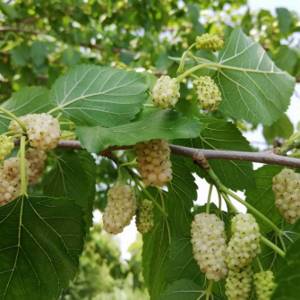
Mulberry diseases
Our plant is one of those that rarely succumbs to disease, but it does happen. Let's talk about the most common misfortunes for mulberries.
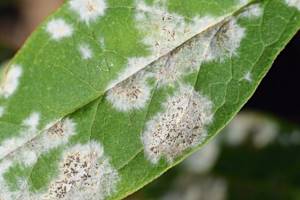
What does powdery mildew look like on plants?
Powdery mildew
This disease is one of the most common plant diseases - fungal. It is characterized by the appearance of a white coating on the leaves and is most dangerous during drought, especially when the crown thickens. The fight against the disease consists of treating the tree with a fungicide (for example, slaked lime and copper sulfate). It is also advised to burn fallen leaves every autumn to prevent infection.
Cylindrosporiosis
This is also a fungal disease. It consists in the formation of red-purple spots on the surface of the leaves. Over time, the affected areas darken and fall out, holes form, and the leaves themselves turn yellow and fly off.
When the first symptoms of Cylindrosporiosis are detected, the plant must be sprayed with Silit solution (0.1%), spending up to 3 liters per tree; after 2 weeks, re-treatment should be carried out. It is better to do this treatment before the buds swell. And, of course, as with the previous disease, the fallen leaves should be collected and burned, since it is in them that the pathogens of the disease wait out the cold.
Bacteriosis
The essence of the disease is the damage to leaves and young shoots by spots of small size and irregular shape, which gradually darken to black. The affected foliage curls and flies off during the course of the disease. In shoots, the disease proceeds differently - elongated brown spots appear, which cause their external deformation. It is recommended to fight the disease with phytoflavin and gamair. It is not always possible to cure a plant, so it is better to try to reduce the possibility of infection. As always, the best way to combat disease is prevention. Preventive treatments should be carried out using the means already mentioned above.
Small leaf curl
This is a viral disease that greatly reduces the yield of mulberries. The disease is transmitted by insects and consists in the fact that over time the foliage loses color, curls up and decreases in size, and the stems become brittle and rough, although an abnormal increase in their number occurs.
Unfortunately, effective methods for combating small leaf curl have not yet been invented. And although small-leaved curl cannot be treated, there is always prevention, which includes the fight against insects that carry the disease. At the top of this list are all sucking pests, for example: horseflies, aphids, scale insects, flat bugs, mites, and so on.
tinder
The tinder fungus is dangerous because it gradually destroys the tree on which it has settled. This is due to spores that, falling on various cracks, tumors and other damage to the bark, parasitize the plant, destroying the trunk.
If a tinder fungus is found, it must be removed from the plant along with part of the wood and burned. The affected area should be lubricated with a solution of copper sulfate at a concentration of 5%, and then carefully covered with a specialized mixture, which includes: clay rock, cow dung and limestone in a ratio of 1:2:1.
If any damage is found on the surface of the trunk from which sticky juice flows, the wounds should be cleaned. And then urgently treat them with the already familiar solution of copper sulfate, only this time at a concentration of 1%. Next, treat them with a solution of Nigrol with sifted wood ash in a ratio of 7:3.
Mulberry pests
Pests rarely attack mulberries, but it still happens. We will talk about insects to which mulberry is susceptible to attack below.
White American butterfly
This is the most dangerous pest for mulberries, so let's start with it. Butterfly caterpillars are capable of destroying huge amounts of leaves in one sitting. They look like this: brownish-greenish larvae with orange-yellow stripes on the sides and black spots. If spider nests are found on a tree, they should be urgently cut off and burned, specialized trapping rings in the form of a wide strip of ordinary tape, foil or fly tape should be placed on the trunk, and the mulberry crown should be treated with Chlorophos.
Mulberry moth
The caterpillars of this pest also feed on young foliage. The method of dealing with them is exactly the same as in the previous case - treating the crown with Chlorophos. For preventive purposes, it is better to carry it out in the spring, at the time when the buds begin to swell, because that it is at this time that the appearance of the pest is observed.
Spider mites
These are pests that not only suck cell sap from leaves, as a result of which the foliage darkens and crumbles. But on top of that, they are also one of the main carriers of many incurable diseases that are viral. It is impossible to see the ticks themselves, because they are very small, but it is not difficult to identify them by the thin web in which they hide. To exterminate the pest, various chemicals are used, for example: Avermectin, Pirimifos-methyl, Sunmite, Kleschevit, etc.
Comstock's worm
The cellular sap of the tree is a real sweetness for this insect, and by drinking the enchanting drink over and over again, it greatly weakens it. It is responsible for the formation of tumors and wounds on the tree, as well as for the modification and drying out of branches. Pesticide helps in the fight against scale insects.
Botanical description
The mulberry tree grows very quickly in its youth, but gradually growth slows down and eventually the plant reaches a height of no more than 15 m. The leaves of the mulberry are simple, often lobed, jagged along the edges, alternate. Small, spiked mulberry flowers can be male or female (dioecious), but on some (monoecious plants) both can open at the same time. The fleshy fruits of the mulberry, 2-3 cm long, are false berries, connected together by drupes of different colors - from white to dark purple or almost black.
Mulberry is completely unpretentious and can grow without any care. The tree begins to bear fruit in its fifth year of life. Mulberries live up to 200 years, but there are mulberries that are already five centuries old.
In cultivation, mainly two types of mulberry are grown - white and black, and they are distinguished not by the color of the fruit, but by the color of the bark: the branches of white mulberry have a light shade of bark - yellowish, cream or white, and the branches of black mulberry have much darker bark.
- Goji: cultivation, properties, types
Today, mulberries are as popular among gardeners as the time-tested apple, cherry, sweet cherry, plum and other fruit trees that have long been established in our gardens, which is why we offer you information on how to plant and care for mulberries and propagate mulberries from cuttings and in other ways, growing and caring for mulberries in the Moscow region, protecting the mulberry tree from diseases and pests, and we will also tell you how mulberries are useful and which varieties are the most popular in amateur gardening.
Properties of mulberry: benefits and harms
Mulberry is famous not only for the juiciness and sweetness of its berries, but also for their benefits. It is immensely rich in useful properties: vitamins A, K, C, B1,2,6 and PP, beta-carotene, iron, phosphorus, magnesium, calcium and many, many others.
Mulberry prevents the formation of blood clots and is used in the prevention of hypertension, heart attacks and strokes. Helps with heavy physical overload and during rehabilitation after operations, because it helps the formation of new blood cells.
Some more popular uses of mulberries in medicine:
- if you have acute respiratory infections, bronchitis or bronchial asthma, drink an infusion of bark and berries;
- for constipation, ripe mulberry fruits help, and for the reverse process and heartburn - green, unripe berries;
- sore throat? Dilute berry juice with boiled water and rinse;
- For insomnia and stress, a decoction of dried berries will be a good helper.
- got hurt or hurt? Brush the mixture with crushed bark and butter.
- and if you suffer from ringworm (a very contagious skin disease), drink the juice of fresh berries.
- Mulberries contain a lot of potassium, and therefore are recommended for hypokalemia.
During pregnancy and lactation
This is the time when the issue of healthy eating should be approached more strictly. Here it is worth remembering again the beneficial properties of mulberry:
- Protects the pregnant woman’s body, improving her well-being, and nourishing the baby with all the vitamins and elements contained in berries;
- Allows you to compensate for the lack of enzymes;
- Nourishes the body with a sufficient amount of phosphorus, which takes an active part in the development of the child’s nervous system;
- Milk will be more nutritious if you eat the fruit of the mulberry tree (introduced gradually);
- Increases lactation.
Mother's milk is irreplaceable, and the baby's health depends on its quality.
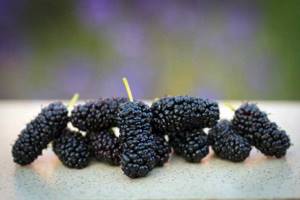
If a child is prone to allergic reactions, it makes sense to get specialist advice on relevant issues, and under no circumstances consume mulberries in the first months of feeding.
